My Take on the Carbon Dioxide Narrative: Part 4: The Sun and Astrophysics
Introduction
Part 3 of what turned out to be a mini-series (! this wasn’t the intent!) covered the real reason behind Earth’s temperatures past and present — the Sun. This massive object is almost 99.9% of the total mass of the Solar System, and converts 4 million tonnes of matter into energy every second.
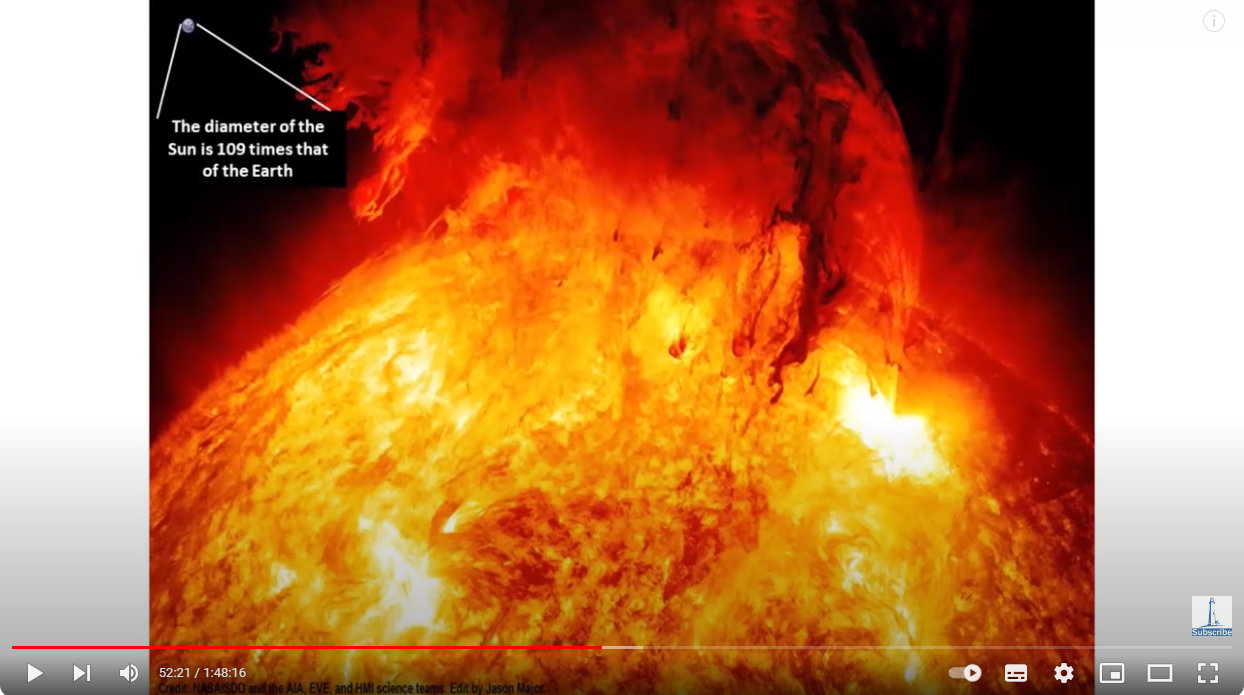
Source: https://youtu.be/1zrejG-WI3U?t=3141
We see some of this energy as light and we feel the rest of it as heat (temperature). Why is it so radical a concept that this massive, powerful body called the Sun influences temperatures more than anything else possibly could? Just standing outside on a warm sunny day as large clouds cover the Sun is enough to notice a drop in ambient temperature.
Carbon dioxide (CO2) is literally a trace gas of just 0.04% of the atmosphere, and there is no credible evidence that temperature follows CO2 — if anything, CO2 lags temperature by 800 years.
Below is a chart (also used in Part 2 of this series) of temperature and CO2 levels over the past 500 million years:
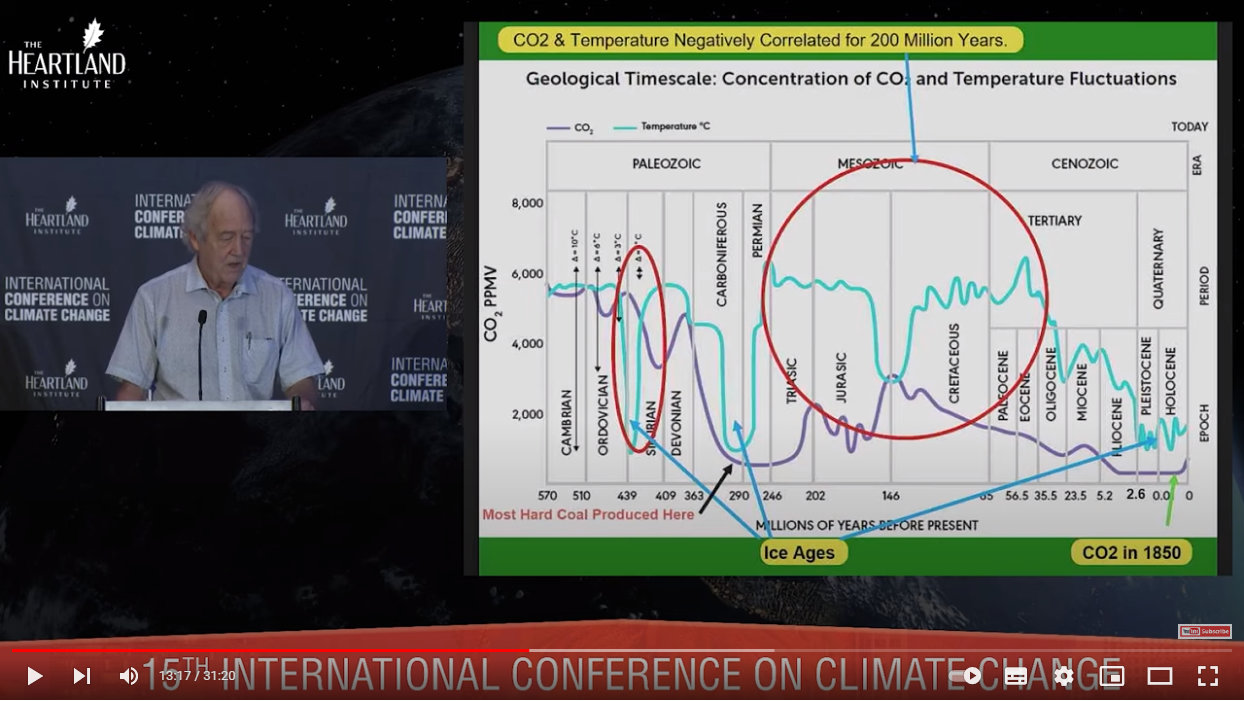
Source: https://youtu.be/GH8v5aCbZBs?t=797
Notice how, in the red circle, temperature at one point is significantly at its lowest whilst CO2 is at its highest, and that there is an overall negative correlation of temperature with CO2 — over a 200 million year period!
The reason temperatures go up and come down is not due to trace gases, but because of sunspot activity — a link made by Jack Eddy in the 1970s who connected the Maunder Minimum with the dearth of sunspots during that time.
The following slide (also used in Part 1 of this series) shows this correlation well, especially when compared with the poor correlation of temperature and CO2 alongside.
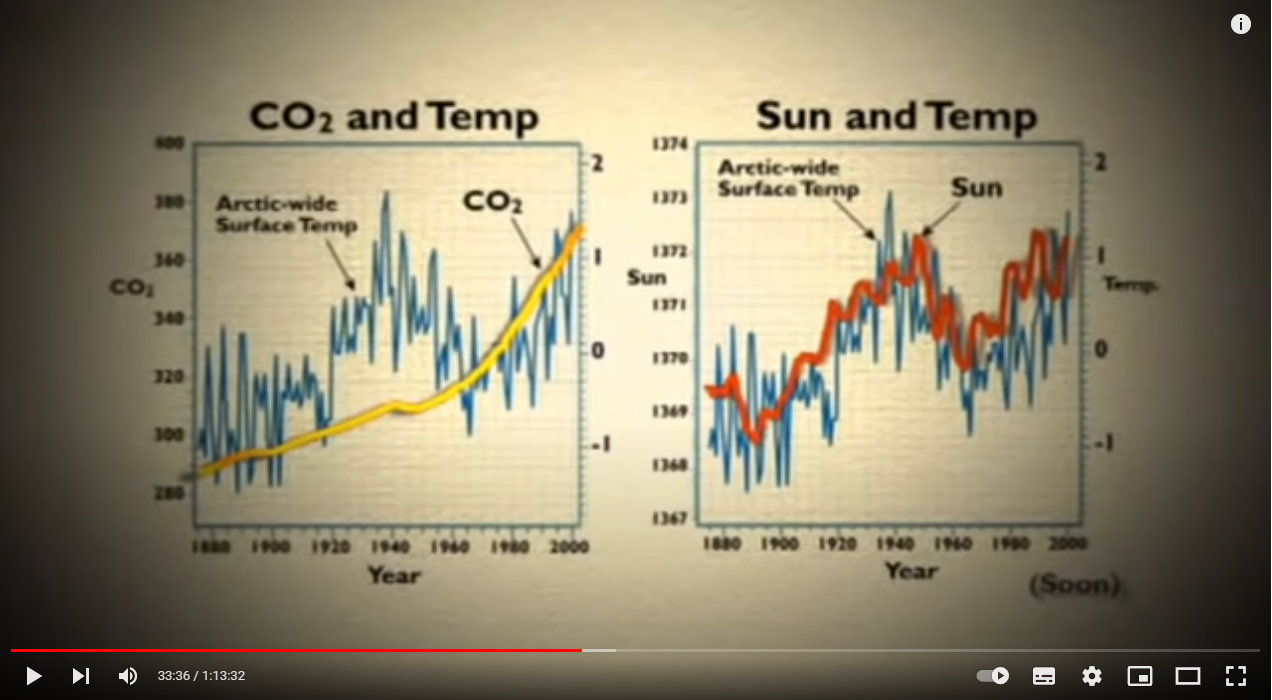
Source: https://youtu.be/BY-gRFSaP7o?t=2016
Part 3 highlighted the work of Professor Valentina Zharkova who, with her team, derived a mathematical model for sunspot activity so accurate, that running it backwards over thousands of years aligned over and over with other famous cooling and warming events.
[An aside regarding models — the purpose of a model is not to predict the future, it is to understand the past. A model which does not align strongly with known, recorded events means the inputs were wrong, and need to be reassessed.]

Source: https://youtu.be/Bl2gg7lT7OM?t=324
But why this oscillation? Why were there cooling and warming events at all, and why will there be cooling and warming events to come?
Not only are these due to sunspot activity occurring in cycles, but due also to the movement of the Sun itself occurring in cycles. Explaining these movements means delving into astrophysics, so let’s begin!
I shall refer to this Valentina Zharkova 2019 Grand Solar Minimum Interview to do so. Please note that the screenshots I present may be out of order as to how they appear in the video where this makes my discussion easier.
The Solar System
In that interview, Professor Zharkova says “our Sun, well they tell us this story […] of the Sun sitting in the focus* of the ellipse, and planets rotate around it, in the same ecliptic [plane], it is a nice story for children. In reality it doesn’t [laugh], everything doesn’t look like it seems.”
*In mathematics, a focus is a point which helps define a curve. A circle has one focus called its centre, or origin, and every point on that circle is equidistant from that focus — the definition of a circle. An ellipse has two foci, and for every point on the ellipse, the sum of its distance to each focus is equal to the sum of the distances for every other point on the ellipse — the definition of an ellipse. (A circle is actually a special type of ellipse, whereby both foci overlap.)
In the below diagram, the two foci of an ellipse are labelled F1 and F2. Mentally reduce the length of each semi-major axis to be the same length as the semi-minor axis and you’ll visualise a circle taking shape as the two foci overlap and meet in the centre — or have a play here!
Please take the time to understand this concept, as this becomes important in the perihelion and aphelion discussion below.
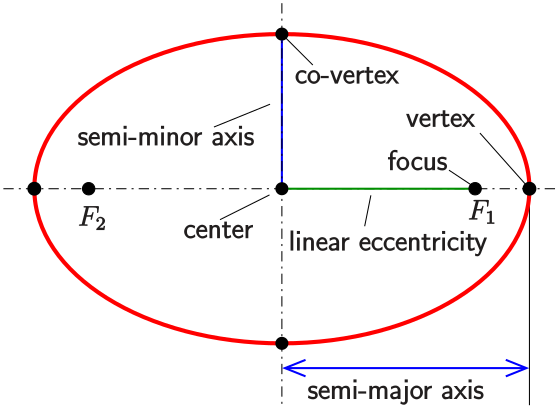
Attribution: Ag2gaeh, CC BY-SA 4.0 , via Wikimedia Commons
What Zharkova is saying is that this is not really what our Solar System looks like:
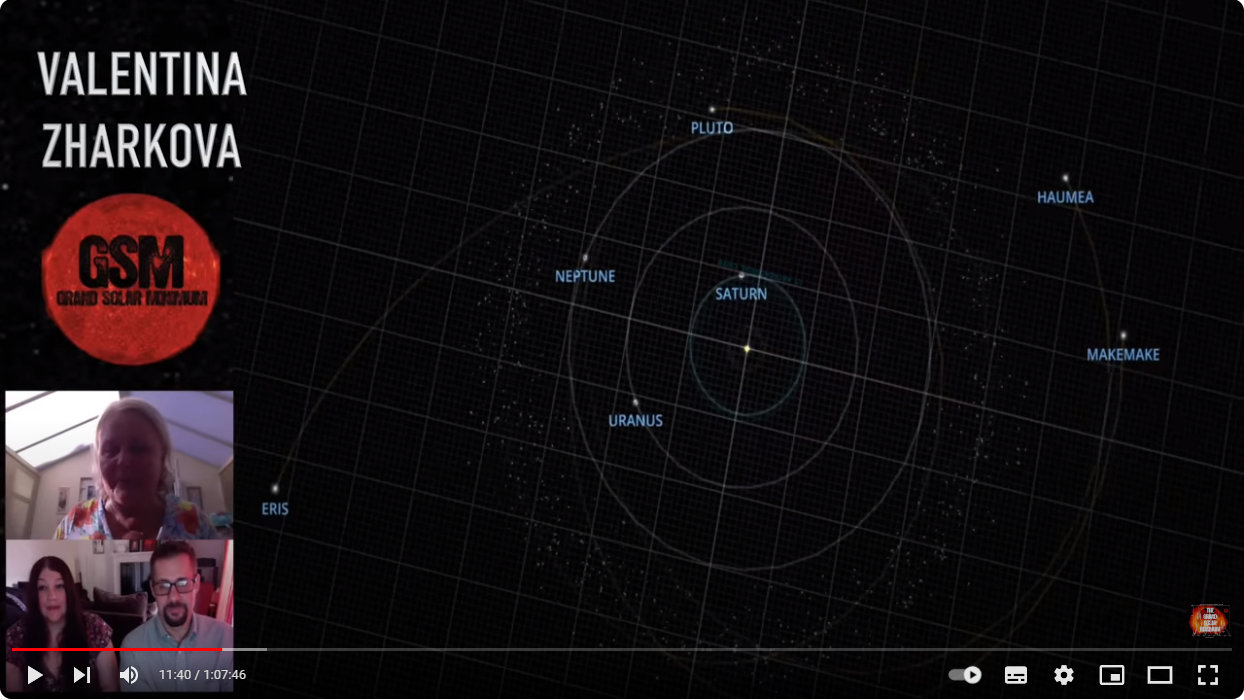
Source: https://youtu.be/Bl2gg7lT7OM?t=700
Rather, the ecliptic planes (orbital paths) of each of the planets are out by a few degrees with respect to each other, and the Solar System in motion looks more like this! (I highly recommend clicking the image to view the animation.)
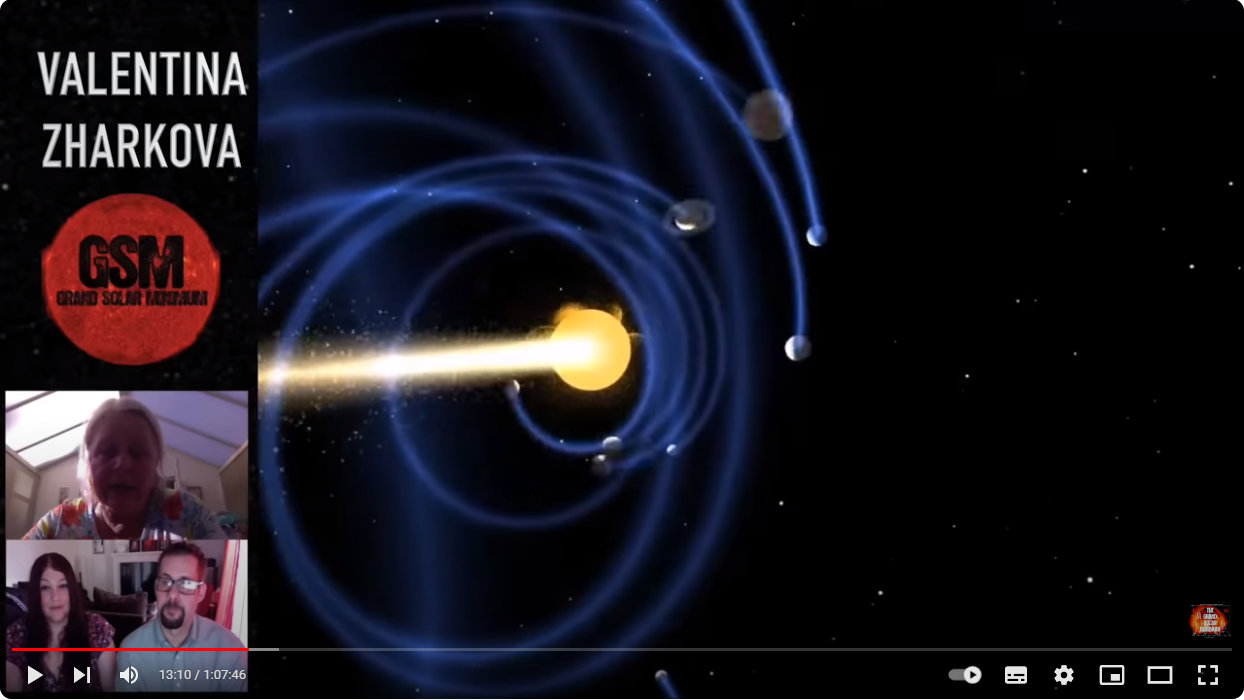
Source: https://youtu.be/Bl2gg7lT7OM?t=790
On Barycentres
This motion is due to all bodies of the Solar System, the Sun included, rotating around a point called the barycentre. The barycentre, in astronomy, is both the centre of mass between two or more bodies orbiting one another, and the point about which they orbit. It is not a physical object.
Below is a representation of two bodies of extreme differences in mass — such as the Sun and Earth — rotating about a common barycentre. (Other examples with different body masses are here.)

Attribution: Zhatt, Public domain, via Wikimedia Commons
Please note the significance here: that an object (Earth) just one-three-hundred-and-thirty-thousandth the mass of another (the Sun) can still exert enough influence as to cause a “wobble” in the Sun’s movement.
And in viewing the other animations at the above barycentre link, note how orbits such as the Moon about Earth, and Charon about Pluto, are around their own localised barycentres again. Now take into account the larger planets with multiple moons (and rings), each with their own local barycentres too. Factor in the asteroid belt for more complexity.
Consider now that all these bodies and regions are in turn orbiting the Sun and, in addition to their own local barycentres, further share a common barycentre with the Sun and each other. This is incredibly complicated stuff, and despite the Sun being almost 99.9% of the total mass of the Solar System, all these bodies are directly affecting the Sun’s own orbit, as it affects theirs.
(And the Solar System in turn orbits the centre of the Milky Way galaxy once every approximately 230 million years.)
This motion of the Sun about the barycentre of the Solar System is called the solar inertial motion (SIM), and the diagram at far right of this slide
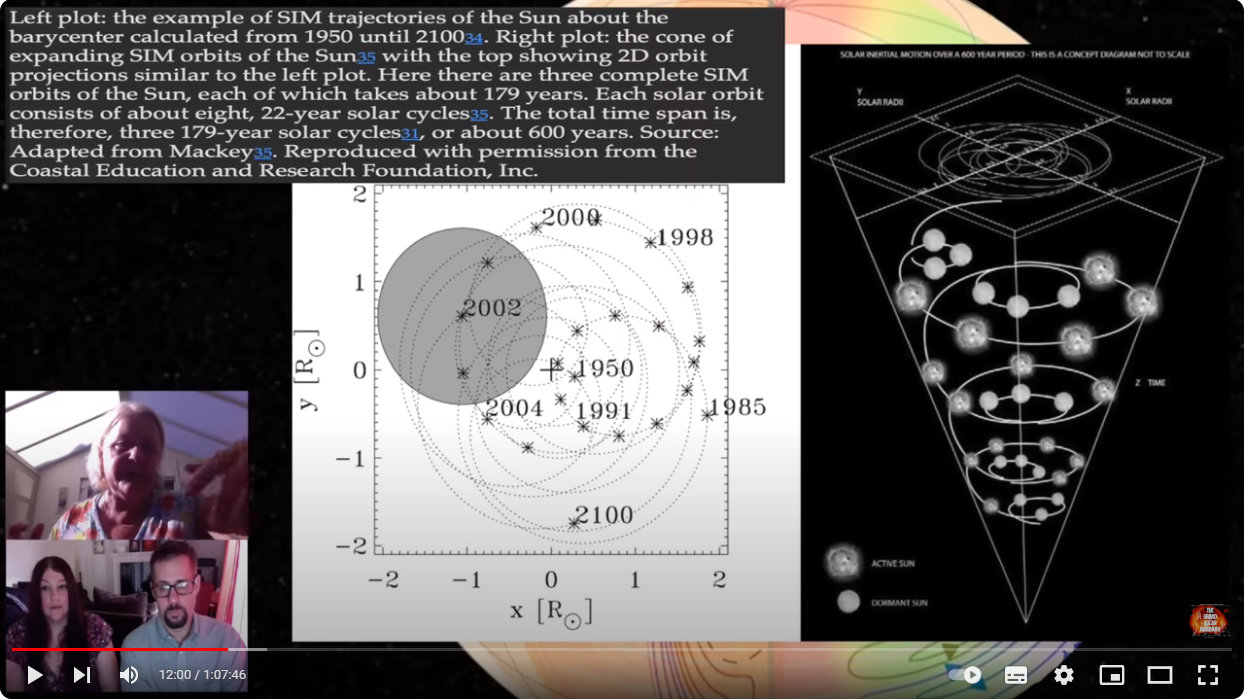
Source: https://youtu.be/Bl2gg7lT7OM?t=720
is from Richard Mackey’s December 2007 paper Rhodes Fairbridge and the idea that the solar system regulates the Earth’s climate.
The planets make the Sun move in a spiral rotation, and this solar inertial motion so far appears to be the only fact which best explains the 2, 000 year super-grand cycle of the Sun.
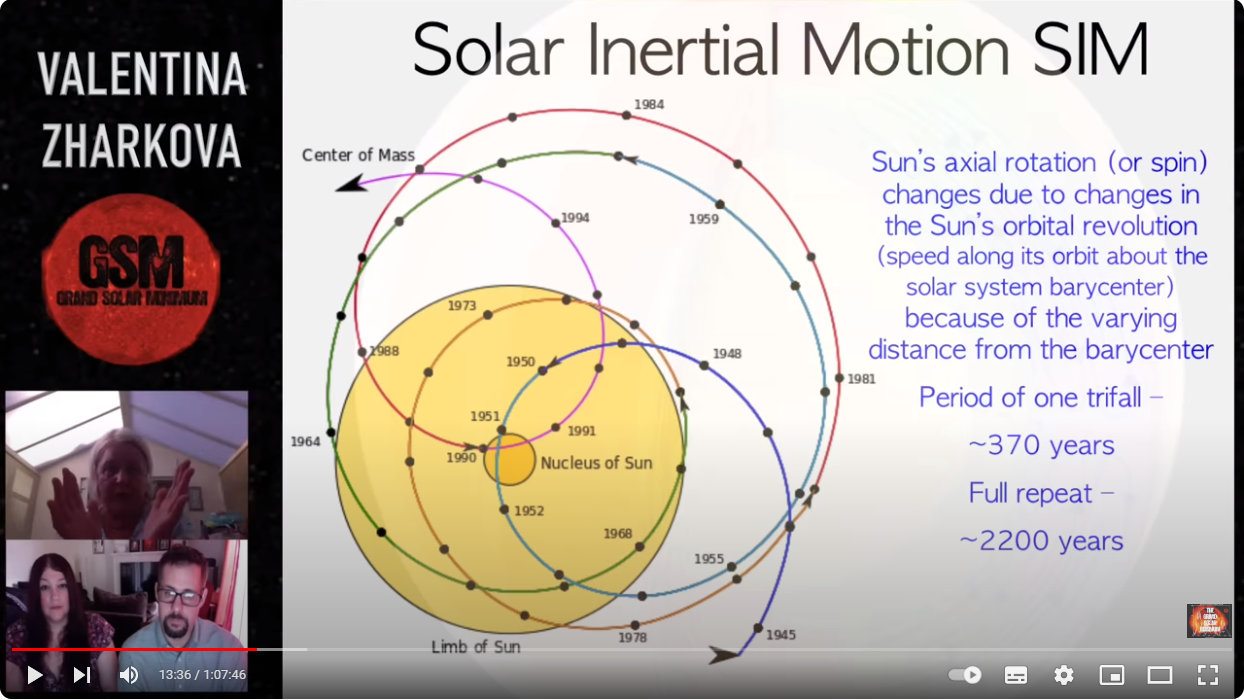
Source: https://youtu.be/Bl2gg7lT7OM?t=816
A simulation of this motion can be viewed by clicking on the image below:
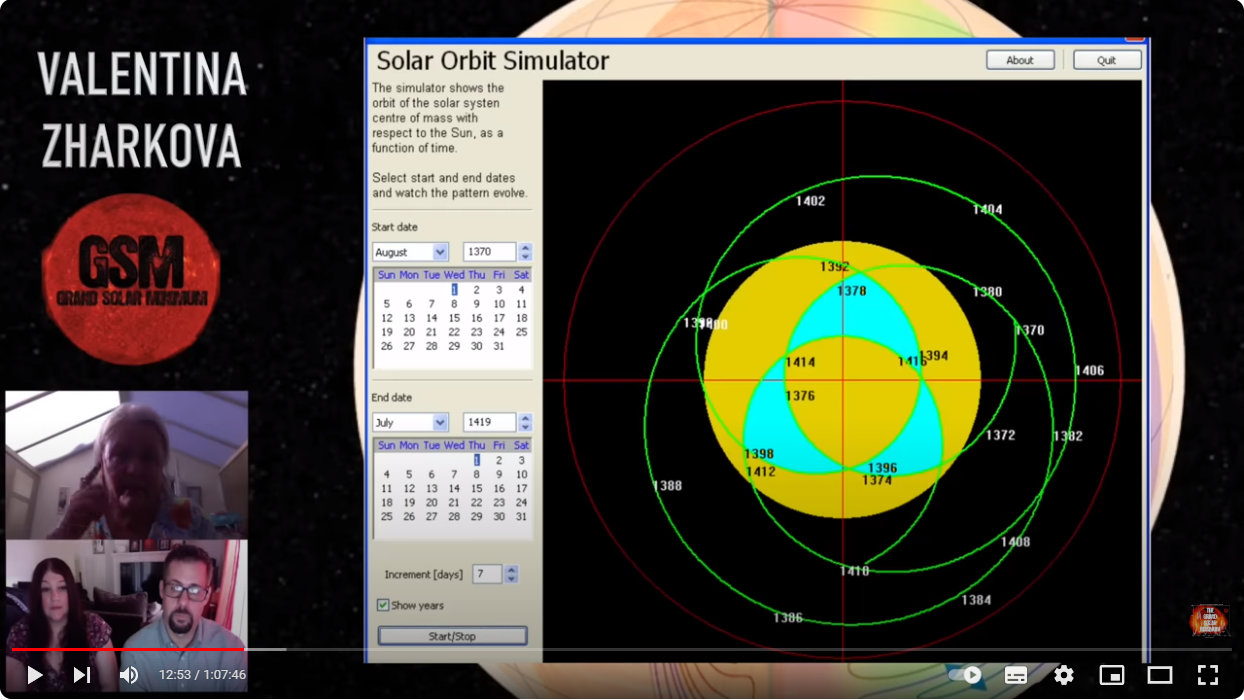
Source: https://youtu.be/Bl2gg7lT7OM?t=769
These movements of the Sun means it cannot sit in one focus all the time with the planets rotating about it, as per the “nice story for children". But let’s first backtrack a bit before explaining the significance of this with respect to global temperatures.
On Perihelion and Aphelion
Perihelion and aphelion are two astronomical terms concerning the orbit of a body around the Sun. Perihelion is the closest distance of said body to the Sun and aphelion is the furthest distance.
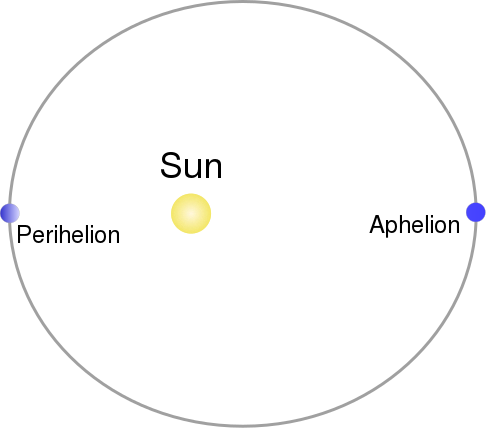
Attribution: Chris55, CC BY-SA 4.0 , via Wikimedia Commons
The Earth in its orbit about the Sun reaches perihelion in early January and aphelion in early July every year. The dates vary slightly from year to year, but for this year 2023 those were 4th January and 6th July respectively. Next year 2024 these will be on 3rd January and 5th July respectively.
This means the northern hemisphere’s winters and southern hemisphere’s summers are during perihelion, and the northern hemisphere’s summers and southern hemisphere’s winters are during aphelion.
The Sun With Regards to Earth in All This
The Sun cannot stay fixed in the focus of Earth’s orbit owing to its SIM. Rather, it will move either closer to perihelion or closer to aphelion.
Should it move closer to aphelion, the Earth’s orbit will become more circular. The Earth’s orbit slows and exposure to the Sun’s magnetic field increases as a result of this motion.
And should the Sun move closer to perihelion, the Earth’s orbit becomes more elliptical, and exposure to the Sun’s magnetic field decreases as Earth’s distance from the Sun increases.
The Earth orbit’s semi-major axis is a constant, thus it is the lengthening and shortening of the semi-minor axis which changes the eccentricity of Earth’s orbit. A shortening semi-minor axis increases eccentricity (makes the ellipse more pronounced), while a lengthening semi-minor axis reduces eccentricity (makes the ellipse more circular).
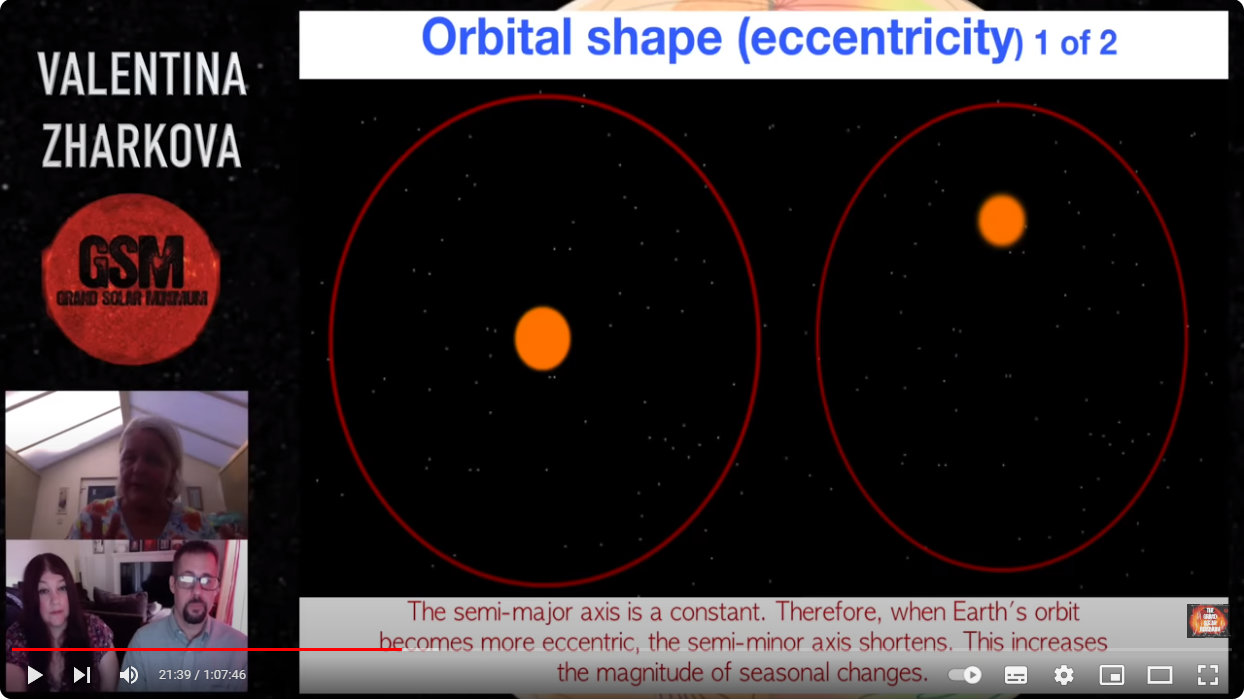
Source: https://youtu.be/Bl2gg7lT7OM?t=1299
[Play with this interactive diagram to learn more about eccentricity and how the value changes from 0 for a full circle to approaching 1 for a very elongated ellipse. (At 1 the curve is a parabola, but this is not obvious from that diagram.)]
Click on the image below to see this Sun-Earth movement animated:
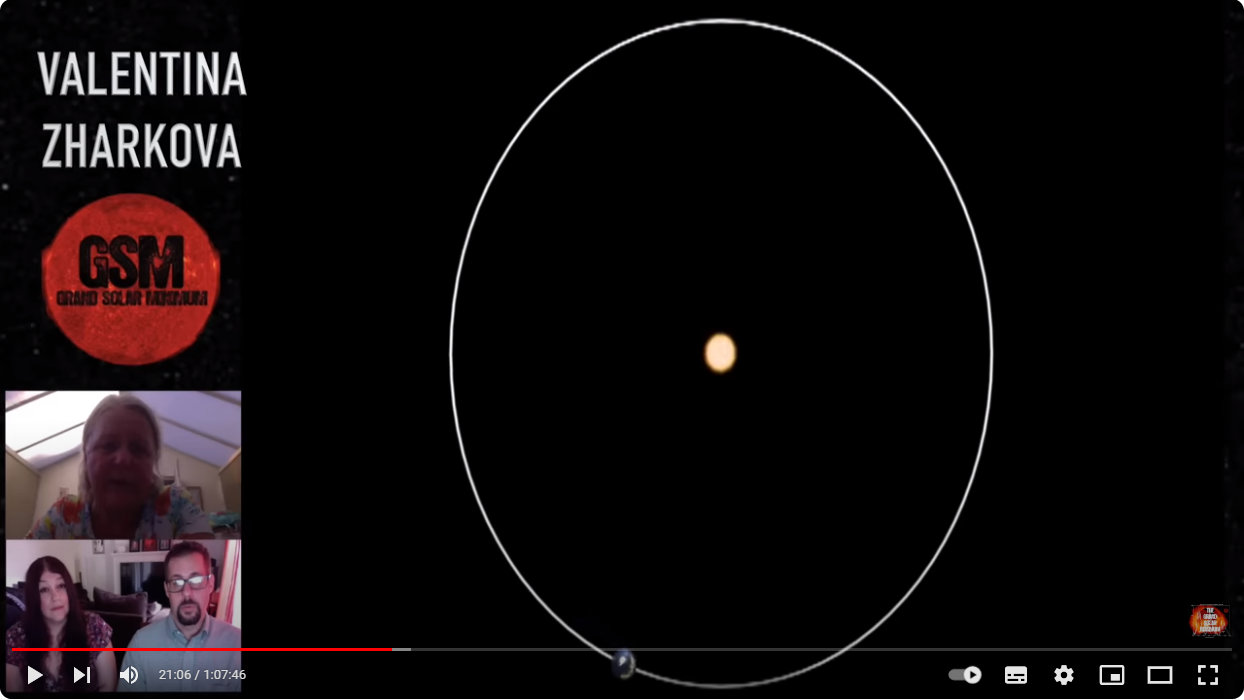
Source: https://youtu.be/Bl2gg7lT7OM?t=1266
The Sun’s movements over hundreds and thousands of years causes the shape of Earth’s orbit to fluctuate, which in turn affects Earth’s proximity or distance to the Sun over this time. It is these significant changes which are ultimately behind the changes in climate and temperature on Earth.
The Sun, Perihelion, Aphelion and the Earth Summarised
The Solar System is not a static collection of planets orbiting a fixed Sun in a fixed ecliptic plane, but rather is a complex system of multiple bodies influencing each other’s orbits whilst rotating about a common Solar System barycentre.
The Sun itself moves in a spiral-like motion over about 2, 000 years, which changes its position relative to the Earth over this time.
The Earth’s orbit is an ellipse (high eccentricity) when the Sun is in one of the foci of the ellipse.
Earth is at perihelion when it is closest to the Sun. This occurs in early January, when the northern hemisphere is in winter and the southern hemisphere is in summer. Even when the Sun is at the focus, winters are still always cold in the northern hemisphere, as the Sun never gets closer to make them warmer.
But when the Sun moves closer during its rotation cycle towards aphelion (when the Earth is furthest from the Sun, in July) it moves closer to the centre of the ellipse, and away from the focus. This forces Earth’s orbit to become more circular (low eccentricity). This leads to much hotter summers in the northern hemisphere, but also milder winters in the southern hemisphere for the same reason — Earth as a whole is simply much closer to the Sun at this time of year than it would have been during other aphelion periods within the Sun’s millennial cycles.
And when the Sun is moving away from the focus, it is also much further away from perihelion, and much closer to the centre of a more circular Earth’s orbital. This results in much colder northern hemisphere winters and less hot southern hemisphere summers compared to previous perihelion periods.
Conclusion
The Sun’s rotation cycles over both hundreds of years (grand cycles) and thousands of years (super-grand cycles).

Source: https://youtu.be/Bl2gg7lT7OM?t=1427
This has happened over and over during Earth’s 4.5 billion years, and will continue to happen until the Sun goes supernova in about 5 billion years, as the Sun is a very stable oscillator.
The three participants of the 2019 interview discussed how the northern hemisphere’s growing season was already noticeably shorter with their colder winters, and how this would worsen with each subsequent year for the next 30 years. Professor Zharkova stressed that despite these colder winters they should still expect warmer summers as the Sun moves closer to aphelion.
All three skirted the topic owing to its politicisation, but all agreed that CO2 had no bearing on temperatures, and it was hoped that the work of Zharkova and her team would help others join the dots and accept that the Earth is a stable dynamic system forever warming and cooling, and that we should simply embrace and live with this fact.
The Earth is projected to increase in temperature by 3-3.5 °C by 2600 (! do the maths as to what this increase is on a year-by-year basis, though as mentioned earlier, this increase will oscillate up and down in a gently upwards trend rather than be a linear projection) but nothing dramatic will happen, as this has happened before and it will happen again.
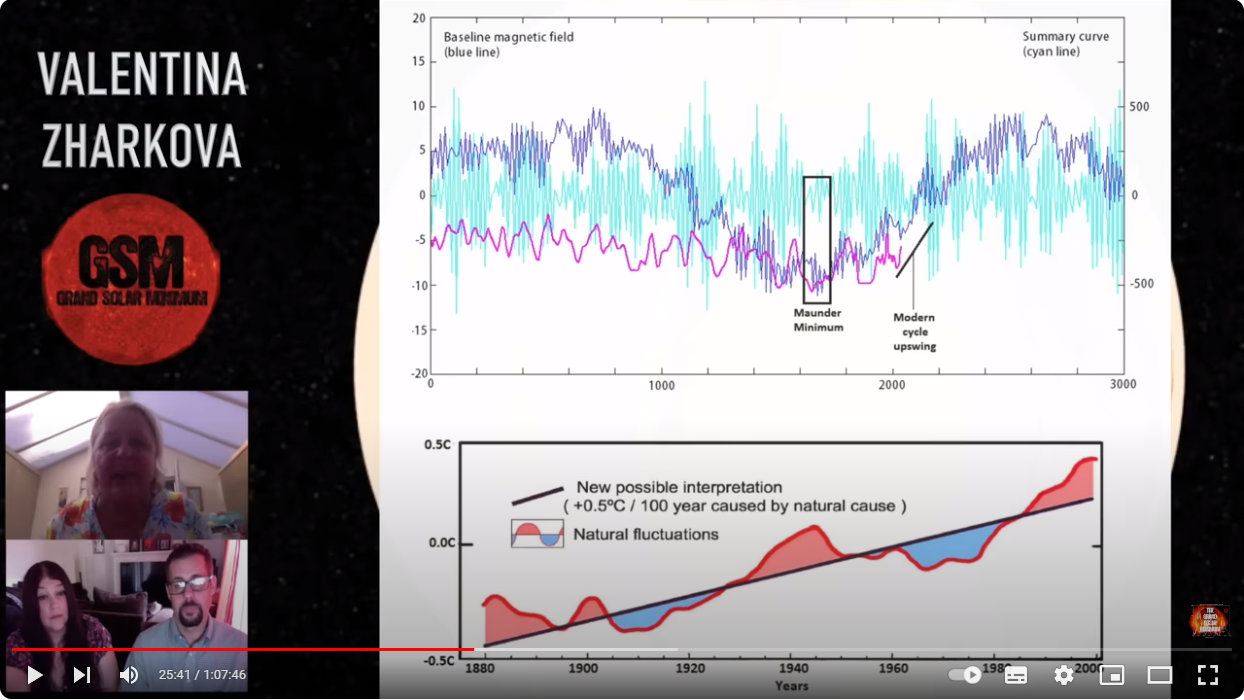
Source: https://youtu.be/Bl2gg7lT7OM?t=1541
This 3-3.5 °C projection is via mathematical analysis showing a half degree increase every 100 years — real-time temperature variations are actually so small as to be very difficult to measure these year-to-year. Life on Earth is just not that fragile as to be affected in any significant way.
And once this 3-3.5 °C increase is reached in 2600, the magnetic field will once again decrease and temperatures will again gently oscillate downwards. This is all natural. Just as our arctic ice was melting, so too was Mars’ polar ice caps — and what human activity was melting those?
About the Author
BSc(Hons), U.Syd. - double major in biochemistry and microbiology, with honours in microbiology
PhD, U.Syd - soil microbiology
Stumbled into IT and publishing of all things.
Discovered jujube trees and realised that perhaps I should have been an agronomist...
So I combined all the above passions and interests into this website and its blog and manuals, on which I write about botany, soil chemistry, soil microbiology and biochemistry - and yes, jujubes too!
Please help me buy a plant if you found this article interesting or useful!